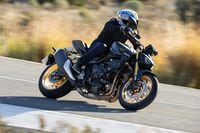How many lanes are there on a two-lane road? Trick question? Not really…
Motorcycle Safety Foundation instructors describe a motorcyclist's "lane" as being broken into left, middle and right, but that's just the beginning. It would be more accurate to say a singletrack vehicle can occupy an infinite number of segments in a given space. Practically speaking, the number of locations a bike can occupy in one 12-foot-wide lane is huge.
Experienced riders have a variety of lane-position rules and superstitions. Depending on the situation, you can be in one place or another, from the edge of the shoulder to the middle of the road. For instance, at dusk and dawn you want to be on the lookout for deer and other critters, which means avoiding the right side of the lane. Of course, that theory assumes the roadway is more alien to animals than the roadside.
Being closer to the middle of the road gives oncoming vehicles a better chance of seeing you. When you’re following a semi, SUV or some other oversized fuel-drain, riding near the centerline can prevent an oncoming vehicle from attempting an ill-timed pass.
Practice the outside-inside-outside “racing line” in corners, entering as far to the outside as possible so you have the space and time to make corrections. Delayed apexes are great, too, particularly in blind corners. The later you define a curve’s apex, the sooner you can see the exit and get back on the gas.
Managing lane position is a two-dimensional tactic. Extra distance is your friend in traffic because it gives you extra time to figure out your next move and make it. The MSF recommends allowing 2-4 seconds between the car ahead and you. At 70 mph you’re covering approximately 100 feet per second, which is a convenient mental tool for calculating following distance. Counting “one potato, two potato...” while approaching a stationary reference point helps calibrate your brain, too.
Since one of the least endearing qualities of modern drivers is their irrational love of tailgating, a well-calibrated brain goes a long way toward keeping you out of trouble. The average driver’s poor mathematical understanding makes it tough. Running up against the next car’s bumper in traffic decreases his average speed _and _that of all the vehicles behind him. He’d be better off going slow and keeping his distance than constantly stopping and starting. Tell that to distracted commuters: If they aren’t darting from lane to lane, they’re out of gas by the side of the road or waiting in the middle for the cops to show up after rear-ending some poor soul.
If an offending motorist is following too closely, try varying your speed. Slow down until the driver passes, or build some distance between the one ahead and you, then gradually speed up. When the offensive one catches back up, slow down again to rebuild your safety margin. Bozo will soon take his clown act somewhere else. If that doesn’t work, pull off the road and wait for the joker to pass.
Here’s one more for the road: Assume most drivers are malevolent idiots until proven otherwise. Underestimating the skills, intent and prevailing attention level of your fellow motorists makes you appreciate competent, decent drivers all the more. Choosing the best lane position is a moment-by-moment decision, so stay tuned-in to your riding environment. Hope for the best but plan for the worst, even if it happens right in front of you.












/cloudfront-us-east-1.images.arcpublishing.com/octane/2WF3SCE3NFBQXLDNJM7KMXA45E.jpg)
/cloudfront-us-east-1.images.arcpublishing.com/octane/G4MG6OUCJNBSHIS2MVVOTPX65E.jpg)
/cloudfront-us-east-1.images.arcpublishing.com/octane/IIGGWFOTOJGB7DB6DGBXCCMTDY.jpg)
/cloudfront-us-east-1.images.arcpublishing.com/octane/QSTCM6AVEZA5JJBUXNIQ3DSOF4.jpg)
/cloudfront-us-east-1.images.arcpublishing.com/octane/U4I7G625B5DMLF2DVIJDFZVV6M.jpg)
/cloudfront-us-east-1.images.arcpublishing.com/octane/B6XD6LS6IVCQPIU6HXDJSM3FHY.jpg)
/cloudfront-us-east-1.images.arcpublishing.com/octane/ICL63FEDDRDTTMINYICCEYGMDA.jpg)
/cloudfront-us-east-1.images.arcpublishing.com/octane/FCGZHQXRBZFLBAPC5SDIQLVF4I.jpg)
/cloudfront-us-east-1.images.arcpublishing.com/octane/WNOB6LDOIFFHJKPSVIWDYUGOPM.jpg)

/cloudfront-us-east-1.images.arcpublishing.com/octane/X33NU3E525ECRHXLNUJN2FTRKI.jpg)
/cloudfront-us-east-1.images.arcpublishing.com/octane/6KKT5NNL2JAVBOXMZYS5ZO76YA.jpg)
/cloudfront-us-east-1.images.arcpublishing.com/octane/J5RKG5O455GMPGQRF2OG6LRT7A.jpg)
/cloudfront-us-east-1.images.arcpublishing.com/octane/GX2CIZKQVRH2TATDM26KFG2DAE.jpg)
/cloudfront-us-east-1.images.arcpublishing.com/octane/ZWIDYSAKQZHD5BHREMQILXJCGM.jpg)
/cloudfront-us-east-1.images.arcpublishing.com/octane/CYUHJZCTSJCH3MRAQEIKXK7SCQ.jpg)
/cloudfront-us-east-1.images.arcpublishing.com/octane/LKOFINY56FCXJCANJ5M7ZDQUBY.jpg)
/cloudfront-us-east-1.images.arcpublishing.com/octane/4NBPDACMWJH63JQYJVK3QRBDZI.jpg)
/cloudfront-us-east-1.images.arcpublishing.com/octane/KKHQHRR3FJGX7H2IPU6RALMWG4.jpg)

/cloudfront-us-east-1.images.arcpublishing.com/octane/5IOFS5JAE5FOXMNA23ZRAVVYUU.jpg)
/cloudfront-us-east-1.images.arcpublishing.com/octane/CGXQ3O2VVJF7PGTYR3QICTLDLM.jpg)

/cloudfront-us-east-1.images.arcpublishing.com/octane/OQVCJOABCFC5NBEF2KIGRCV3XA.jpg)